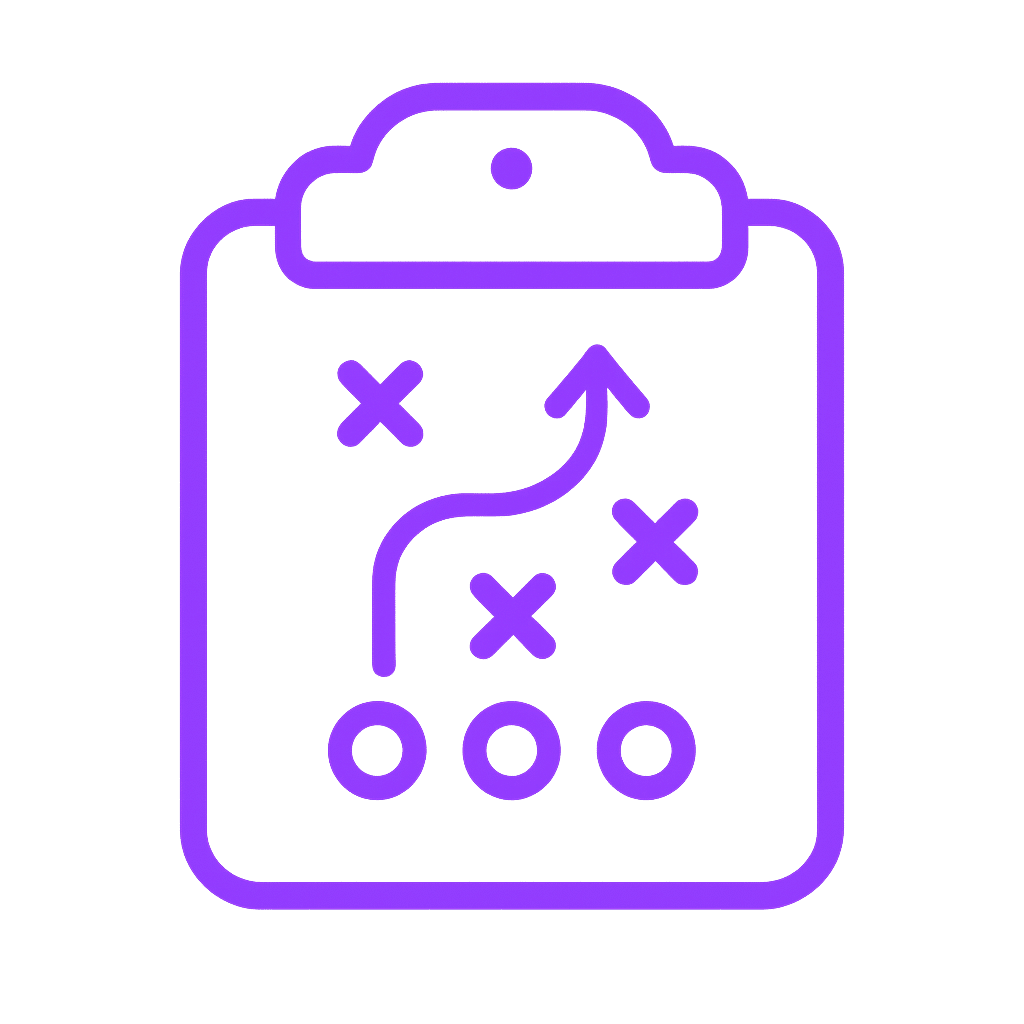
In countless conversations with small and midsized business (SMB) founders, a striking pattern emerges: a psychological blind spot in competitive thinking. Ask who their competitors are, and many point to industry behemoths, the “800-pound gorillas” that dominate headlines and market share.
I once met the founder of a niche project management tool built for creative agencies. When asked about competition, the reply was immediate: “Asana.” While Asana is undeniably a leader in the project management space, its audience, feature depth, and positioning are engineered for a much broader and different use case. The comparison wasn’t just apples to oranges; it was apples to an entire fruit basket.
This reflex is understandable. Giants symbolize what SMBs aspire to: recognition, scale, and dominance. But focusing on them can be strategically misleading. By fixating on giants, businesses risk overlooking competitors who are closer in size, speed, and target market; competitors who are more likely to attract the same customer base and respond to market changes with similar agility.
And by ignoring these closer competitors, SMBs miss vital insights. Trends in pricing, messaging, product decisions, and customer behavior often emerge among peers operating in the same trenches. These competitors may not have the resources of the 800-pound gorilla, but they can outmaneuver you if you’re not paying attention.
That’s when the realization hit: founders need a better way to map their competitive landscape. One that moves beyond instinct and gut feeling. One that captures the nuance of real-world similarity across customer segments, value propositions, and strategic intent.
That insight became the foundation of ImpelHub’s competitive analysis methodology: a structured, data-driven way for SMBs to see the field more clearly and act with sharper strategic focus.
In the sections ahead, we explore how to break the market leader fixation, widen your competitive lens, and adopt systems built for real-world growth, not hypothetical comparisons.
Table of Contents
- The Pitfalls of Overemphasizing Market Leaders
- Broadening the Competitive Lens
- Why a Broader Competitive Lens Matters
- A Structured Methodology for Competitive Analysis
- The Multi-Attribute Similarity Scoring System
- Top Strategic Dimensions for Competitive Evaluation
- From Framework to Insight: Assigning Weights and Calculating Scores
- Mapped Across Major Strategic Categories
- Strategic Advantages: Why Structured Analysis Matters for SMBs
- Implementing the Methodology - ImpelHub’s Approach
- ImpelHub’s Strategic Tools & Workflow
- Application of the Similarity Scoring System
- Case Studies and Success Stories
- Automating Competitive Analysis for Efficiency
- The Strategic Value of Automation
- How ImpelHub Transforms Competitive Monitoring
- Conclusion
- FAQ
The Pitfalls of Overemphasizing Market Leaders
Why do small businesses keep comparing themselves to big brands like Amazon or Apple?

It’s a pattern we’ve seen time and again at ImpelHub: well-intentioned SMB founders pouring over the strategies of market giants, trying to reverse-engineer success from the top down. While benchmarking against industry leaders can seem like a smart move, it often leads to flawed assumptions and costly detours. Below are the five most common and critical pitfalls we’ve observed when SMBs over-index on the “800-pound gorilla.”
1. Misaligned Strategic Focus
When the competitive lens zooms in on dominant players, it often blurs out those who are vying for the same customers. SMBs that model their strategy on enterprise-level competitors risk crafting solutions and positioning that don’t resonate with their real audience. Meanwhile, similarly sized companies, often faster, scrappier, and closer to the ground, are winning over customers through precision and contextual relevance. Strategy misalignment like this can quietly derail growth.
2. Overlooking Emerging Threats
Big names might dominate headlines, but disruption rarely starts with the giant. It’s the rising players, those experimenting, iterating, and gaining momentum in niche markets, that often pose the most immediate threat. By fixating on legacy leaders, SMBs risk overlooking innovative competitors who may not be well-known yet but are steadily building traction in the same space.
3. Resource Misallocation
Large corporations operate with entirely different economics. Their budgets, brand awareness, and infrastructure allow them to pursue strategies at a scale most SMBs simply can’t replicate. Yet many small businesses unknowingly chase these same tactics, whether it’s overinvesting in feature sets meant for the mass market or mimicking high-cost marketing campaigns. This results in strained resources, low ROI, and strategic fatigue. The better path is one grounded in realistic, high-leverage moves tailored to the SMB’s unique context.
4. Neglecting Unique Value Propositions
Trying to “be like the leader” often dilutes what makes an SMB unique. By chasing parity with the biggest players, companies lose sight of their edge: the reason their customers chose them in the first place. Whether it’s personalized service, a niche feature, or local expertise, that distinctiveness should be sharpened, not suppressed. Unfortunately, an obsession with what the gorilla is doing can make businesses forget why they exist at all.
5. Inadequate Competitive Analysis
Finally, one of the most damaging effects of overemphasizing market leaders is an incomplete view of the real competitive landscape. Too many SMBs limit their analysis to a handful of well-known names, missing out on a more dynamic picture that includes direct rivals, adjacent solutions, and new entrants. A true strategic edge comes not from watching the obvious but from understanding the full field and anticipating shifts before they go mainstream.
At ImpelHub, these insights were instrumental in shaping our approach to competitive intelligence. They reinforced the need for SMBs to adopt a broader, more structured method, one that surfaces relevant threats, highlights true peers, and anchors decisions in reality, not reputation.
Broadening the Competitive Lens
How can small businesses stand out when big brands dominate the market?

If focusing on the “800-pound gorilla” blinds SMBs to what’s truly happening around them, then broadening the lens is how they reclaim strategic clarity and stand out in the chaos. In today’s fast-moving markets, competition doesn’t just come from those who look like you. It comes from adjacent players, innovators in stealth mode, and even brands your customers don’t yet perceive as alternatives until they do.
At ImpelHub, we work closely with founders and leadership teams to map not just the obvious competitors, but the full spectrum of rivals shaping their ecosystem. We see how a narrow competitive focus can distort strategy, leading companies to miss threats and overlook opportunities. To counter this, we recommend a three-tiered model that goes beyond the basics: one that includes direct, indirect, and emerging competitors.
Let’s illustrate this with a relatable example: you’ve launched a fitness app focused on home-based strength training. Who are you really competing with?
1. Direct Competitors
These are the players operating in the same space with similar offerings aimed at the same customer base. For your app, direct competitors would be other workout apps offering similar routines, tracking features, and pricing models. You’re likely competing with them on product features, messaging, and customer experience.
Monitoring direct competitors is necessary, but focusing exclusively here risks tunnel vision. You’ll miss the broader market moves that influence customer behavior in less obvious ways.
2. Indirect Competitors
Indirect competitors solve the same core customer problem but through a different solution path. In our example, this might include local gyms, YouTube fitness channels, or wearables that provide basic workout guidance. They don’t offer the same product, but they compete for the same goal: helping users stay fit.
These players influence customer choices. Ignoring them can lead to missed signals and weak positioning. Understanding indirect competition sharpens your differentiation and expands your market awareness.
3. Emerging Competitors
Emerging competitors are often the most underestimated. They might not be in your lane yet, but they’re nearby and moving fast. Think of a health-focused meal delivery brand adding fitness content or a mental wellness app expanding into physical coaching. They may not look like competition now, but they’re shaping customer expectations.
Spotting these players early helps you adjust proactively rather than react under pressure.
Why a Broader Competitive Lens Matters
Seeing the full competitive landscape exposes unseen threats and highlights untapped opportunities. At ImpelHub, we’ve seen how expanding competitive awareness transforms business decisions from reactive to strategic. Here’s why this matters:
Spotting Market Gaps: With a full-field view, businesses can see where customer needs are underserved. These white spaces often hold the key to launching new features, niches, or service models that competitors haven’t yet addressed.
- Anticipating Trends: Indirect and emerging competitors often act as early indicators of where the market is heading. Monitoring their moves helps you spot evolving customer preferences and industry shifts before they become mainstream.
- Sharpening Strategy: A robust view of the landscape supports smarter decisions, whether it’s refining product positioning, reprioritizing the roadmap, or investing in the right marketing channels.
- Reducing Risk: A narrow focus can leave you vulnerable. A wider lens mitigates the risk of being caught off guard by players you didn’t know you were competing with until they’ve captured your customers.
Expanding your competitive lens isn’t just about adding more names to a list; it’s about seeing your market with clarity, depth, and foresight. At ImpelHub, this expanded view is a core part of how we help businesses navigate complexity, uncover hidden threats, and act on opportunities that others miss.
A Structured Methodology for Competitive Analysis
In high-stakes markets, guesswork is no longer a strategy, especially for SMBs operating with limited time, capital, and margin for error. Competitive awareness must evolve from anecdotal observations to a repeatable, evidence-backed practice.
At ImpelHub, we’ve engineered a structured methodology that replaces gut feeling with granular intelligence: a multi-attribute similarity scoring system that quantifies how closely another business resembles yours and how seriously it should be taken as a competitive threat.
This approach equips SMBs with a sharper lens to identify, compare, and prioritize competitors in a way that is consistent, scalable, and strategic.
The Multi-Attribute Similarity Scoring System
At its core, this methodology evaluates competitors across a curated set of dimensions that define market behavior and relevance. Each dimension is scored individually, weighted by importance, and then aggregated into a composite similarity score. This structured process ensures you’re not just aware of your competitors, but you understand where they overlap, where they differ, and where they pose the greatest risk or opportunity.
This scoring system empowers SMBs to:
- Benchmark competitors with analytical precision, not assumptions.
- Uncover blind spots, such as indirect or emerging players outside the usual radar.
- Focus strategic efforts where competitive pressure is highest.
Top Strategic Dimensions for Competitive Evaluation
These dimensions form the backbone of our methodology, covering everything from business fundamentals to nuanced ecosystem alignment. Here’s how each one contributes to a richer, more accurate view of your competitive landscape:
1. Industry and Sub-Industry Alignment
Measures how structurally similar a competitor is to your business in terms of sector and niche. This dimension filters out irrelevant players and sharpens focus on those serving parallel ecosystems.
2. Target Audience Overlap
Evaluates alignment in ideal customer profiles, use cases, and buyer psychology. Two businesses may offer different products but compete fiercely if they solve similar problems for the same customer segment.
3. Product or Service Similarity
Look at feature sets, pricing tiers, and value propositions. A near-identical offering increases competitive tension, especially if it’s paired with stronger positioning or better UX.
4. Technology Integration Level
Assesses the sophistication, adaptability, and depth of the technology stack behind the solution. Competitors with superior integrations, automation, or AI capabilities can often capture market share faster, even with a comparable core product.
5. Business Model Alignment
Compares how companies generate revenue, deliver value, and scale, whether via subscriptions, pay-per-use, or bundled services. Similar models often mean similar growth motions and bottlenecks, making competition more direct.
6. Go-to-Market Strategy
Reviews the methods used to reach and convert customers, including channels (direct sales, marketplaces, channel partners), messaging, and funnel architecture. Even distinct products can become competitive if they fight for visibility in the same acquisition zones.
7. Geographic Focus
Measures overlap in geographic presence by country, region, or locality. Local players often hold distribution advantages, while international competitors may bring pricing pressure, making geographic mapping critical for context.
8. Growth Stage/Maturity
Determines whether competitors are early-stage, growth-phase, or enterprise-scale. This shapes their risk appetite, agility, and go-to-market velocity. Understanding where they are on the maturity curve helps predict their likely moves.
9. Customer Experience Model
Analyzes how competitors engage customers through service quality, support, and overall user experience. Differentiated experiences influence not just acquisition but long-term retention and upsell paths.
10. Ecosystem & Platform Fit
Look at third-party integrations, strategic partnerships, and API openness. Companies embedded within popular ecosystems (e.g., Salesforce, Shopify, Microsoft) often enjoy defensibility and cross-sell leverage that others cannot replicate.
11. Revenue Scale & Velocity
Compares top-line revenue and growth trajectory to gauge a competitor’s resource advantage, pricing leverage, and market penetration. While not a strategic differentiator by itself, revenue context helps assess how formidable a competitor is, and whether their growth is organic, funded, or stagnant.
From Framework to Insight: Assigning Weights and Calculating Scores
Each attribute is weighted to reflect your business priorities. For example, a SaaS platform prioritizing deep integrations might assign greater weight to ecosystem fit, while a regionally focused brand may emphasize geographic reach.
Competitors are then scored on a consistent scale (e.g., 1–10) for each attribute. The individual scores are multiplied by their respective weights, then totaled to generate an overall similarity index. This provides a ranked, apples-to-apples view of which players truly matter and why.
Strategic Advantages: Why Structured Analysis Matters for SMBs

Most SMBs operate in resource-constrained environments. They can’t afford to chase every competitor, monitor every move, or spin their wheels reacting to headlines. That’s why a structured model like this is transformative. Here’s what it unlocks:
- Sharper Strategic Focus
Instead of reacting to every visible competitor, this approach filters out the noise and highlights those that truly overlap with your customers, model, or positioning. It narrows your focus to what really threatens or shapes your growth trajectory.
- Objective, Bias-Free Insights
Competitive analysis often suffers from subjective opinions or legacy assumptions. A multi-dimensional scoring system introduces objectivity, creating consistent criteria that reduce guesswork and align cross-functional teams on who matters most and why.
- Smarter Resource Allocation
When you know who’s a real threat, you can act accordingly. Product teams can prioritize differentiators, marketing can fine-tune messaging, and sales can tailor playbooks. Every decision becomes more focused and justifiable.
- Agile, Real-Time Market Awareness
Markets shift, and this framework shifts with them. As new entrants emerge or existing players pivot, your scoring can evolve to reflect current realities. That keeps your analysis relevant, not outdated.
Implementing the Methodology - ImpelHub’s Approach
At ImpelHub, competitive analysis is a systematic, intelligent process designed to drive results. By combining the precision of AI with the judgment of strategic experts, ImpelHub transforms raw data into practical insights, giving SMBs a crystal-clear view of their competitive landscape.
ImpelHub’s Strategic Tools & Workflow
At the heart of ImpelHub’s platform lies what we call the “Business Brain,” a living, contextual knowledge model tailored to your business’s industry, offerings, audience, and growth stage.
This foundation powers a suite of integrated tools that work in harmony:
FoeScope
The first step in any competitive analysis is knowing who you’re really up against. Uses a multi-dimensional similarity scoring framework to surface your five closest competitors, not just obvious ones, but those truly contending for the same audience, market share, and positioning. Once identified, each competitor is dissected for strengths, blind spots, and opportunities to counter their edge.
CounterEdge
Knowing a competitor exists is only half the story. CounterEdge tracks what your competitors are doing. It evaluates the growth plays of your competitors, filters them through relevance to your business, and delivers precise, customized countermeasures based on threat level, gaps, and your unique strengths.
Battleboard™
To map and prioritize your position relative to the competition, Battleboard™ steps in as your dynamic benchmarking engine. It visualizes how your company stacks up across dozens of strategic dimensions, ranging from product innovation and messaging clarity to sales channels and operational scale. By mapping these against your closest competitors, Battleboard™ helps identify where you’re leading, lagging, or perfectly positioned to create strategic separation. It’s the bridge between analysis and action, guiding resource allocation and growth priorities with precision.
NextMove
Filters hundreds of potential strategies down to the top 16% most impactful and feasible for your business. Each strategy is scored using proprietary Impact and Innovation metrics, benchmarked against your current phase, ICPs, and competitive position. This ensures you only invest in high-ROI moves, no guesswork, just clear direction.
Playbook
The Playbook turns selected strategies into a custom, phased rollout plan tailored to your business. It aligns each move with real-world constraints, growth goals, and buyer segments. With step-by-step checklists, metrics, and integration guidance, your Playbook ensures every strategy is not just smart — it’s ready to implement.
Application of the Similarity Scoring System
Underlying ImpelHub’s methodology is a refined similarity scoring system designed to keep your focus on the most relevant competitors. It evaluates multiple dimensions such as industry niche, product features, target audience, and technology integration, assigning weighted scores based on strategic context. Rather than treating all competitors equally, this system cuts through the noise to spotlight those with real market impact. The result is focused, data-driven clarity that drives smarter strategic decisions.
Case Studies and Success Stories
The true test of any strategy lies in real-world outcomes. At ImpelHub, our methodology has consistently delivered measurable transformation across diverse industries. Here are three client stories that illustrate how structured competitive intelligence turns challenges into growth opportunities:
PineTree Motors: B2C Roots to B2B Resilience
Once primarily focused on consumer vehicle sales, PineTree Motors partnered with ImpelHub to explore new market directions. Using our insight framework, they uncovered a high-potential B2B segment previously underleveraged. By refining their credit offerings and expanding fleet management services, the company successfully pivoted to a 75% B2B revenue model, securing deeper partnerships and a stronger position in a crowded market.
TreatLyme: From Algorithm Setback to Strategic Comeback
TreatLyme, a health platform, experienced a sharp 40% drop in revenue following major search algorithm shifts. ImpelHub stepped in to develop a cohesive recovery strategy, unifying platform experiences, strengthening SEO, and optimizing content for user intent. The result was a return to stability and a scalable structure for future growth.
NSOSI: Building a Community-Driven Investment Ecosystem
As NSOSI prepared to launch an exclusive network for strategic investors, they needed clarity on audience segmentation and growth pacing. ImpelHub mapped out critical market segments and developed phased entry strategies to balance exclusivity with scalability. This laid the groundwork for a vibrant, self-sustaining investment community and informed their long-term roadmap.
Automating Competitive Analysis for Efficiency
The Bottlenecks of Manual Analysis
For many SMBs, traditional approaches to competitive analysis are still largely manual, like scraping websites, scanning news alerts, scrolling through competitor social channels, or compiling data in spreadsheets. While feasible in early-stage operations, this approach quickly becomes unsustainable as markets evolve and competitors multiply.
Manual analysis often leads to several core inefficiencies:
- Time-Intensive Research: Manually sourcing and validating competitive data consumes valuable hours that could otherwise be spent on strategic initiatives. The pace of decision-making slows, and by the time insights are gathered, the market may have already shifted.
- Information Overload, with Minimal Actionability: The abundance of publicly available data like financial updates, customer reviews, press releases, and pricing changes can overwhelm teams without clear systems for filtering, contextualizing, and prioritizing that information.
- Human Error and Inconsistency: Without standardized frameworks, analyses can vary widely in quality and depth. Key details may be overlooked, leading to flawed assumptions and strategic missteps.
- Blind Spots and Missed Signals: No team can monitor every potential competitor around the clock. This creates dangerous visibility gaps, particularly with fast-moving startups or sector-adjacent players entering your space unnoticed.
The Strategic Value of Automation
Automating competitive analysis doesn’t just streamline operations; it redefines what’s possible. By introducing intelligent systems into the research and monitoring process, businesses can access insights that are deeper, broader, and more timely than manual methods can offer.
Key advantages include:
Accelerated Data Processing: Automation drastically reduces the time lag between data collection and insight generation, allowing leadership teams to react to competitive shifts in near real time.
- Always-On Market Surveillance: Modern tools can continuously scan the competitive ecosystem across websites, product listings, social media, news sources, and review platforms, flagging relevant movements without requiring constant human oversight.
- Greater Consistency and Reliability: Automated systems apply consistent criteria and logic to every analysis, reducing the risk of missed data points or subjective bias.
- Actionable Intelligence at Scale: Automation enables businesses to monitor hundreds of data points across multiple competitors simultaneously, delivering synthesized, actionable insights rather than disjointed information.
How ImpelHub Transforms Competitive Monitoring

ImpelHub’s platform is purpose-built to overcome the limitations of manual analysis and bring AI-driven clarity to your competitive strategy.
- End-to-End Automation: Our system autonomously aggregates data across your defined competitive landscape, eliminating the grunt work of sourcing from scattered locations.
- Real-Time Competitive Intelligence: Whether it’s a pricing change, product launch, strategic partnership, or shift in brand positioning, ImpelHub detects and delivers relevant developments as they happen.
- Smart Alerts & Curated Dashboards: Users receive customized reports and proactive notifications tailored to the competitive signals they care most about, so critical insights never slip through the cracks.
- Scalability by Design: Whether you’re tracking five competitors or 50, our solutions grow with you, supporting your expansion into new markets or categories without added operational burden.
Conclusion
Chasing the loudest player in the market might feel strategic, but it often leads teams to misallocate resources, copy irrelevant features, and overlook the real threats. True competitive advantage starts with identifying the right competitors, those who share your customer base, product direction, and go-to-market motion.
At ImpelHub, we’ve built a structured, data-driven system to replace guesswork with clarity. Our Competitive Proximity Scoring model surfaces the rivals that matter most based on measurable similarity, not just visibility. And with automation at its core, insights stay current, relevant, and immediately actionable.
If your strategy is still shaped by the industry giant, it’s time to shift your lens.
Don’t guess. Know who you’re up against and compete with precision.
FAQ
1. Why shouldn't a small business copy what big brands are doing?
Because their goals, budgets, and customer expectations are completely different, what works at scale often fails at smaller sizes. It’s like trying to steer a speedboat using an aircraft carrier manual.
2. As an SMb, how can I identify my competitors?
Start by asking your customers. Questions like “What other options did you consider before choosing us?” or “Why did you pick us over others?” often reveal both direct competitors (who offer similar services) and indirect ones (like DIY tools or internal teams). Customers are the best source of truth.
3. What’s one thing small businesses can do better than the giants?
Speed. You can launch experiments, shift messaging, and talk to real users in hours, not quarters. That kind of responsiveness quickly wins trust and improves product-market fit.
4. Is it okay to study competitors like Amazon or Salesforce?
Yes, but only for inspiration, not imitation. Use their strategies to understand trends or tools, but adapt them through the lens of your stage, audience, and constraints.
5. How should I benchmark my performance instead?
Compare yourself against your past performance or peers at a similar stage, not giants. Track your growth metrics over time. Are you improving conversion rates? Increasing LTV? Lowering churn?
6. What should I prioritize if I’m an SMB with limited resources?
Prioritize:
- Knowing your customer deeply
- Solving one high-value problem well
- Building a reliable, lean growth engine (email, SEO, referrals)
- Delivering delight through support or product usability



